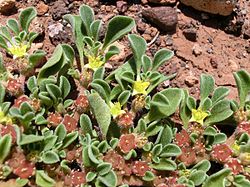| Aizoon canariense | |
|---|---|
 | |
| Scientific classification | |
| Kingdom: | Plantae |
| Clade: | Tracheophytes |
| Clade: | Angiosperms |
| Clade: | Eudicots |
| Order: | Caryophyllales |
| Family: | Aizoaceae |
| Genus: | Aizoon |
| Species: | A. canariense |
| Binomial name | |
| Aizoon canariense | |
| Synonyms [1] | |
Aizoon canariense is a species of small leafy annual plant in the family Aizoaceae. [2]